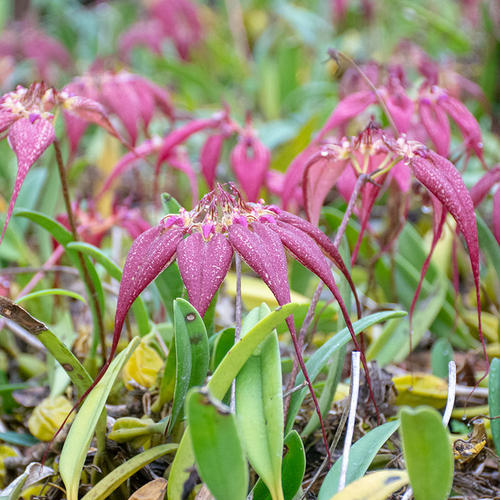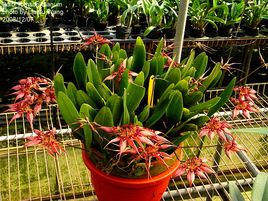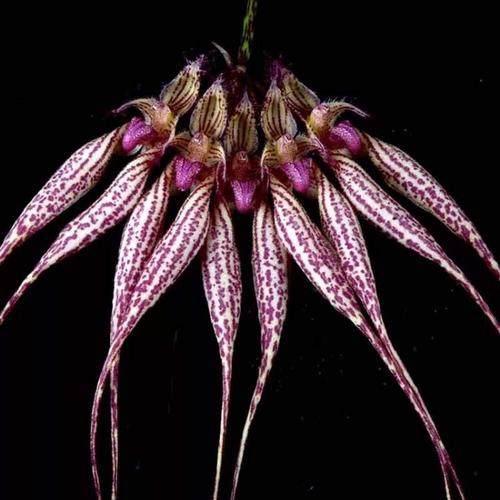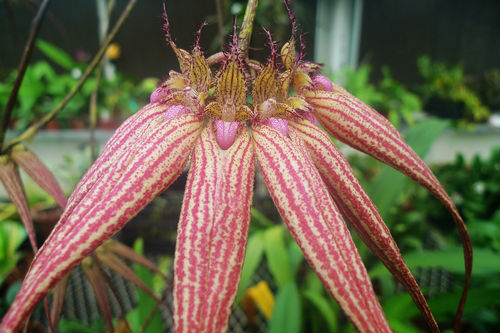Bulbophyllum rothschildianum profile
Written by Maggie
Aug 31 2021

The rhizome of Bulbophyllum rothschildianum is stout, 5 -- 7 mm thick, densely covered by short tube sheathes, on which sparsely grow pseudobulbs. Bulbophyllum rothschildianum pseudobulb is ovoid, terminal 1 leaf. Leaves are thick leathery, nearly elliptic. Scape is drawn from the base of pseudobulb, erect, stout, umbels with 4-6 flowers; The flowers are large, lavender red; Petals of Bulbophyllum rothschildianum are ovate-triangular, ca. 1 cm long, 4 mm wide above base, sharply tapered caudate above middle, with 3 veins, margin as fimbriate as sepals; Lower sepal fleshy, lingulate elliptic; Leading edge of medicine cap, apex concave.
Bulbophyllum Rothschildianum is born on the trunk of a tree in a dense mountain forest at an altitude of 1550 meters. bulbophyllum rothschildianum distributes in NE India of Micro order, south Yunnan, China. Bulbophyllum rothschildianum is cultivated and has high horticultural value.
Bulbophyllum rothschildianum picture

Morphological characteristics of Bulbophyllum rothschildianum
Rhizome
Bulbophyllum rothschildianum rhizome is stout, 5-7 mm thick, densely covered by short tube sheath, on which sparsely pseudobulbs. Pseudobulb is ovoid, ca. 3 cm thick in the middle, terminal 1 leaf, base by scaly sheaths, golden yellow after drying, smooth surface slightly with gloss. Leaves of Bulbophyllum rothschildianum are thickly leathery, subelliptic, usually 9 -- 10 cm long, 2 -- 2.5 cm wide at middle, apex obtuse and slightly concave, base cuneate, with a stalk ca. 1 cm long.
Scapes showed
Scapes of Bulbophyllum rothschildianum drawn from base of pseudobulb, erect, stout, 20 -- 24 cm long, umbels with 4 -- 6 flowers; Pedicle ca. is 4 mm thick, sparsely 3 sheaths; Sheaths are cylindric, membranous, clasped to peduncle, ca. 1 cm long; Bracts of Bulbophyllum rothschildianum are lanceolate, ca. 1 cm long, apex acuminate; Pedicel and ovary are 2 cm long; The flowers are large, lavender red; Middle sepals of Bulbophyllum rothschildianum are ovate, navicular, not including apex tapering, ca. 15 mm long, 7 mm wide above the base, apex acute caudate, with 5 veins, abaxially sparsely papillary, margin fimbriate; The tassel is wide and narrow oblong, up to 7 mm long, easy to fall off; Lateral sepals of Bulbophyllum rothschildianum are lanceolate, 15-19 cm long, acuminate to apex, densely verrucate below middle on the dorsal surface, torsion above the base and upper margin of both sepals glued to each other to form a "calyx"; The "closed calyx" is up to 2 cm wide above the base.
Petals
Petals of Bulbophyllum rothschildianum ARE ovate-triangular, ca. 1 cm long, 4 mm wide above the base, sharply tapered caudate above the middle, with 3 veins, margin with fringe-like hairs like the middle sepals; Labellum is fleshy, lingual elliptic, 1 cm long, posterior half on both sides folded, apex blunt, base and core column foot end connected to form a movable joint, edge and above densely fringed hair; Stamen column length 5 mm; The wing of the Bulbophyllum rothschildianum extends forward in the middle of the pistil column and is triangular. The foot length of the Bulbophyllum rothschildianum is 7 mm, and the separated part is 3 mm. Stamen teeth is subrectangular, ca. 2 mm long, apex becoming narrowly sickle-shaped; Anterior edge of medicine cap concave.
Ecological habits of the Bulbophyllum Rothschildianum
Bulbophyllum rothschildianum generally grows in the mountainside valley wall of deep mountains and valleys, sloping slopes or stone crevices with good water permeability and water retention, beside sparse mountain grasses, and under the shade of secondary miscellaneous trees. Or have shade, the sunshine time is short or only the place where the star leaks light. Where the air is moist and ventilate, it is sometimes built on the side of mountain streams and cliffs.
Bulbophyllum rothschildianum is best grown in a well-ventilated environment. Bulbophyllum rothschildianum likes shade, avoid direct sunlight, like wet, avoid dry, 15℃ to 30℃ most suitable for growth. Poor growth above 35℃. Cold temperature below 5℃ will affect its growth when the orchid is often in a dormant state. If the temperature is too high and the sun is exposed to the sun, the leaves will burn or scorch in a day or two. If the temperature is too low and did not transfer into the house in time, the phenomenon of frostbite will appear.
Bulbophyllum rothschildianum is the fleshy root, suitable for the use of humus-rich sandy loam, drainage performance must be good, should choose leaf rot soil or humus-rich mountain soil. Slightly acidic loose soil or soil containing iron, pH value of 5.5-6.5 is appropriate.
Growing methods of Bulbophyllum Rothschildianum
Humidity: Need in the air humidity is high, humidity is about 70-80%.
Temperature: 18-35°C, minimum night temperature not less than 15°C; Higher daily heat shifts favor flowering.
Watering: regular watering but not water, no dormant period, slightly less watering in winter.
Fertilizer: Apply 1:4 of thin fertilizer.
Bulbophyllum Rothschildianum propagation
Division
In spring and autumn can be carried out division propagation, generally every three years a Bulbophyllum Rothschildianum. Any robust plant with dense pseudocorms can be divided, and at least 5 connected pseudocorms should be stored in each cluster after division. Before planting, reduce irrigation water, so that the potting soil is more than. After planting, cover the bottom hole of the pot with broken tiles, then lay coarse stones, which account for 1/5 to 1/4 of the depth of the pot, then put coarse-grained soil and a small amount of fine soil, and then plant with sandy loam rich in humus. Planting depth to the false corm just buried in the soil strength, basin edge left 2 cm along with the mouth, covered with Cuiyun grass or fine stones, finally pouring permeable, shady place for 10-15 days, keep the soil moist, gradually reduce watering, normal maintenance.
Seed propagation
The seed of Bulbophyllum Rothschildianum is very thin, and there is only one incomplete embryo in the seed, and its germinating ability is very low. Besides, the seed coat is not easy to absorb water, so it cannot germinate by conventional sowing methods. Therefore, Bulbophyllum Rothschildianum fungus or artificial medium is needed to provide nutrients for germination. Planting fruit had better choose not cracking, surface with 75% alcohol after sterilization, remove the seeds, soaking with 10% sodium hypochlorite for 5-10 minutes, take out three times with sterile water rinse again can play in the cultivation of the bottle containing medium, and dark in the pure, the temperature about 25 c, stirring and then moved to the light that can form the original bulb. From sowing to transplanting, it takes half a year to a year. Tissue culture has been successful, and this method can be used to propagate where conditions permit.

Disease control of Bulbophyllum rothschildianum
Disease control
Sheath rust
Usually on the upper and lower surfaces of Bulbophyllum Rothschildianum leaves, rarely on the stem with raised vesicles containing yellow, orange, rusty, or even purplish black powdery spores. Rust is not fatal, nor does it kill the leaves, but it weakens the plant. Prevention and control methods in addition to cut the sick leaves can be used 65% of the sun zinc powder 500-600 times the liquid or containing copper fungicide spray.
Southern blight
Mostly in the rainy season. At the beginning of the disease, the leaf base is full of white silk. Cause root rot.Prevention and control method: remove fungus basin soil, sprinkle on pentachloronitrobenzene powder or lime. Radical cure method: pay attention to ventilation and light, basin soil drainage is good. Severe diseased plants are burned.
Anthrax
It occurs all the year-round and is more prevalent in hot and rainy seasons, especially in Bulbophyllum Rothschildianum. The spots first extend from the tip of the leaf to the rhizome, brown at the beginning, and then gradually expand and increase, there are many dry black spots, seriously cause the death of the whole plant. Prevention and control methods: in addition to actively changing environmental conditions, in the onset period, can be used first with 50% methyl tobujin wettable powder 800-1500 times the liquid spray treatment, once every 7-10 days; Then supplemented with 1% equivalent Bordeaux liquid, once every half a month, continuous spray 3-5 times.
Pest control
Scale insects
Commonly known as "lice". They multiply most quickly in conditions of high temperature, humidity and poor airflow. It can be treated with 1% diethoate oxide or 1500 times 50% mala sulfur spray during incubation period. If the number of pots is not much, it can also be brushed manually.
The distribution of the Bulbophyllum Rothschildianum
Bulbophyllum Rothschildianum is born on the trunk of a tree in a dense mountain forest at an altitude of 1550 meters.
Bulbophyllum rothschildianum is native to southern Yunnan, China (Jinghong, Menghai), and distributed in northeastern India (origin of type specimens).

Latest Updated
- Benefits of Bugleweed - 7 Science-backed Health Benefits
- Bugleweed Dangers & Side Effects - Is It Poisonous?
- How to Plant Evergreen Trees - What You Should Know
- When to Plant Evergreens - Grow Guide for Evergreen Trees
- 12 Wonderful Evergreen Shrubs for Your Garden
- 12 Popular Evergreen Plants with Pictures for Beginners
- When And How To Prune A Lilac Bush Like a Pro
- How to Grow & Care for Lilac Vine (Hardenbergia Violacea)
- Japanese Lilac Tree (Syringa Reticulata) Care & Propagation Guide
- Shumard Oak Pros and Cons - What to Know
Popular Articles
- Winter maintenance of Antirrhinum Majus
- How to Grow Terminalia Mantaly Tree
- How to Grow and Care for Crossostephium Chinense
- How to grow Antirrhinum Majus in spring
- Peristeria Elata (Dove Orchid) Profile: Info & Care Guide
- Underwatered Snake Plant (Sansevieria Trifasciata) - Signs And How To Fix
- How to Care for Brazilian Jasmine Plant (Mandevilla Sanderi)
- How to Grow & Care for Graptopetalum Purple Delight in Summer
- Rosa Chinensis (China Rose): Plant Growing & Care Tips
- How to Care for Baby Sun Rose (Aptenia Cordifolia)